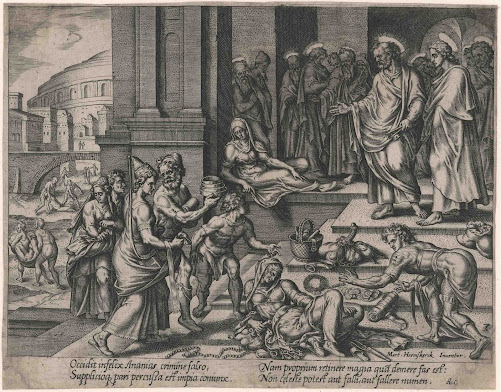Jacopo
Caraglio (aka Giovanni Jacopo Caraglio; Giacomo
Caraglio) (c1500–1565)
“Ariadne” (aka “Ariadne
with a Crown of Stars”), 1526, plate 18 from the
series of twenty plates, “The Gods in Niches” (aka “Mythological
Gods and Goddesses”; “Classical Gods”; “Goden in Nissen”), after Rosso Fiorentino (aka Giovanni Battista de'
Rossi; Giovanni Battista di Jacopo di Guasparre) (1494–1540). Although this
impression is somewhat light in tonal contrast—an attribute documented for
first/second state impressions (see TIB, vol., 28 [Commentary], p. 117)—this is
a lifetime impression before the plate was reworked with the addition
of shading around the niche by Francesco Villamena (1564–1624) in the third
state and before publication by Carlo Losi (fl.c1757−1805) in the fourth and
final state.
Note that this
engraving is deceptively close to the copy of it made by Jacob Binck
(aka Jacob Bink) (1494/1500–1569) in 1530; see http://hdl.handle.net/10934/RM0001.COLLECT.90632;
TIB 16(8).43(274) (Robert A Koch [ed.] 1980, “The Illustrated Bartsch: Early
German Masters; Jacob Bink, Georg Pencz, Heinrich Aldegrever”, vol., 16, New
York, Abaris Books, p. 43, cat. no. 43). One of the differences is in the shape
of the shadow cast by the figure’s bent leg and the variation in the phrasing
(pressure) of the borderline in the same area. The Budapest Museum of Fine Arts
holds a later copy of Caraglio’s engraving after the plate was revised by Francesco Villamena; see: https://www.mfab.hu/artworks/ariadne-plate-18-from-the-series-of-the-gods-in-niches/.
Madeline
Cirillo Archer (1995),
in the commentary volume to “The Illustrated Bartsch”, vol., 28 (New York,
Abaris Books), offers the following marvellous insights into the series (“The
Gods in Niches”) of which this engraving is a part: “…while using niches as
settings, [the portrayed figures] make no attempt to imitate sculpture. In
plasticity, activities, poses, and environment, the figures are emphatically
pictorial in their conception and execution. […] in most of the compositions,
the general effect is of forms either bursting out of the niche, or of balancing
on the edge, their upper bodies possess a spatial ambiguity with the niche
behind. The variety of textures and pictorial use of chiaroscuro increase the
sense that these are not sculpture, but living forms” (pp. 116–17).
Engraving on
laid paper, trimmed along the platemark on the top and sides and within the
borderline on the lower edge with loss of the line of text (“.MORTALIS.BACCHO.PLACVI.QVE.ARIADNA.MARITO.”
[The mortal Bacchus pleased Ariadne as her husband]), backed with a support
sheet.
Size: (sheet)
21 x 11.2 cm.
Numbered in
plate: (lower right corner) “18”.
State i/ii (of
iv). Note that TIB (1995) advises: “Technically, [this print and all the other
plates except for “Saturn”] in the series are not second states, since they do
not record changes to the plates. […] Plates are very worn” (p. 117). This
first/second state impression is before the significant revisions made in the
Villamena edition of the third state.
TIB 2802.041(Robert
A Koch [ed.] 1980, “The Illustrated Bartsch: Italian Masters of the Sixteenth
Century”, vol., 28 Commentary, New York, Abaris Books, pp. 159–60, cat. no. [2802].041).
Condition: a delicate impression with soiling, trimmed along the
platemark on the top and sides and within the borderline on the lower edge with loss of the line
of text. The sheet has been laid upon an archival support sheet of millennium
quality washi paper providing wide margins.
I am selling
this exceptionally rare early/lifetime impression that was interestingly pulled
from the press eight years before Michelangelo commenced work on his “Last
Judgement” in the Sistine Chapel—a remarkable history of folk have held this
print (and left their marks!)—for the total cost of AU$387 (currently US$258.67/EUR234.05/GBP206.03
at the time of posting this listing) including postage and handling to anywhere
in the world, but not (of course) any import duties/taxes imposed by some
countries.
If you are
interested in purchasing this Renaissance period female nude, please contact me
(oz_jim@printsandprinciples.com) and I will send you a PayPal invoice to make
the payment easy.



















































